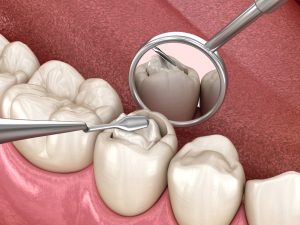Understanding Composite Fillings
Composite fillings are used to restore decayed or damaged teeth. These dental fillings are composed of a blend of plastic and glass materials that bond directly to the natural tooth part, creating a strong and durable restoration. Composite fillings are a popular choice among patients because they seamlessly blend with the natural color of teeth, making them virtually undetectable.
Composite resin fillings may be recommended for various reasons, including:
- Restoring decayed teeth
- Repairing chipped or broken teeth
- Filling gaps or spaces between teeth (diastemas)
- Enhancing the aesthetics of a smile
Advantages of Composite Dental Fillings
Composite fillings offer numerous benefits:
- Natural Appearance: The tooth-colored nature of composite resin fillings makes them more aesthetically pleasing than traditional metal fillings.
- Durability: Composite fillings are robust and long-lasting, providing an enduring solution for tooth decay.
- Versatility: Composite fillings can address a variety of dental issues, including cavities, cracks, and chips.
- Preservation of Tooth Structure: Less tooth structure removal is required to place composite fillings compared to traditional metal fillings.
- Bonding: Composite fillings bond directly to the tooth, creating a tight seal that helps prevent future decay.
- Non-Toxic/Hypoallergenic: Unlike silver (amalgam) fillings, composite fillings don’t contain toxic mercury and are less likely to cause allergic reactions.
Candidacy for Composite Fillings
While composite fillings are suitable for most patients with tooth decay or damage, some may not be ideal candidates, including those with:
- Extensive Tooth Decay: More extensive restorations like dental crowns may be necessary.
- Teeth Grinding: The composite material may wear down more quickly in patients who grind their teeth.
- Large Cavities: These may require more extensive restorations than composite fillings, such as inlays or onlays.
The Composite Dental Fillings Process
Initial Consultation
- Comprehensive Examination: Dr. Michael Nishime will thoroughly examine your teeth using advanced tools and techniques. This may include X-rays to assess the extent of any decay or damage.
- Treatment Discussion: Dr. Nishime will discuss the findings with you, explain the benefits of composite fillings compared to other materials, and address any questions you may have about the procedure, aftercare, or potential costs.
- Determining Suitability: Together, you’ll decide if composite fillings are the most suitable option for your specific dental needs.
Design/Preparation
- Matching Shade Selection: To achieve a natural-looking restoration, Dr. Nishime will carefully select a composite resin shade that perfectly matches the color of your surrounding teeth.
- Tooth Preparation and Anesthesia: Local anesthesia may be administered to ensure your comfort throughout the procedure. The tooth will then be thoroughly cleaned and meticulously prepared to remove any decay or damaged tooth structure.
- Shaping the Foundation: Once cleaned and prepped, Dr. Nishime will shape the remaining tooth structure to create a solid foundation for the composite filling.
Placement
- Layering and Curing: The composite resin material comes in a malleable form. Dr. Nishime will skillfully apply the composite in thin layers, precisely sculpting it to match the natural contours of your tooth. A special curing light will be used after each layer application to harden the resin instantly, ensuring a strong and durable restoration.
- Refinement and Polishing: Once all layers are placed and cured, Dr. Nishime will meticulously refine the shape of the composite filling to perfectly match the surrounding tooth anatomy. Finally, the composite filling will be polished to create a smooth, comfortable, and natural-looking surface that mimics the sheen of your natural enamel.
Caring for Your Composite Filling
To ensure the longevity of your composite dental filling, Dr. Nishime recommends the following aftercare tips:
- Practicing Good Oral Hygiene: Regular brushing and flossing to prevent decay and maintain the restoration and your oral health.
- Avoiding Hard or Sticky Foods: These can damage composite fillings and cause quicker wear.
- Wearing a Mouthguard: If you grind your teeth, a mouthguard can protect your composite filling and prevent further damage.
- Regular Dental Visits: Routine checkups can help detect any issues with your fillings early.
Frequently Asked Questions
With proper care, composite dental fillings can last up to 10 years. However, this can vary based on factors like dietary habits and teeth grinding. Regular dental visits are crucial to ensure your restoration’s longevity and timely replacement if needed.
Yes, composite fillings are safe and have been used for decades. They’re less likely to cause problems compared to amalgam fillings, which can lead to tooth staining, galvanic shock, and allergic reactions.
Most dental insurance plans cover composite dental fillings, but it’s best to check with your provider. You can also discuss in-house financing options with our team to help manage any out-of-pocket costs for filling procedures.
Contact Our Honolulu Dentist for Durable Composite Fillings!
If you’re seeking a Honolulu, HI family dentist who offers lasting, natural-looking composite dental fillings, look no further than Advanced Restorative Dentistry. Our team is dedicated to providing safe, effective, and aesthetically pleasing dental restorations, allowing our patients to smile confidently and comfortably. Reach out to us today at 808-732-0291 to begin your journey to a healthier smile. Dr. Nishime and our team are here to help patients from Honolulu, Kailua, O’ahu, Kapolei, and surrounding areas achieve optimal oral health.





